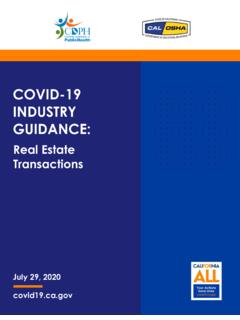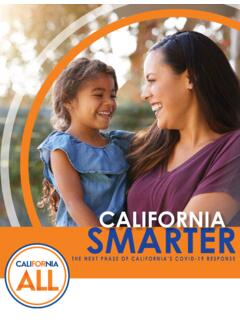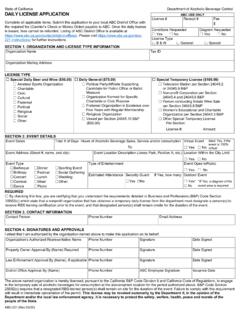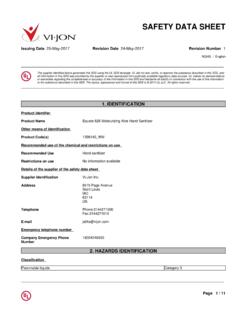Transcription of COVID-19 INDUSTRY GUIDANCE
1 COVID-19 INDUSTRY GUIDANCE : Restaurants November 24, 2020 This GUIDANCE is designed to address sectors and activities opening statewide. However, local health officers may implement more stringent rules tailored to local epidemiological conditions, so employers should also confirm relevant local opening OVERVIEW On March 19, 2020, the State Public Health Officer and Director of the california Department of Public Health issued an order requiring most Californians to stay at home to disrupt the spread of COVID-19 among the population. The impact of COVID-19 on the health of Californians is not yet fully known. Reported illness ranges from very mild (some people have no symptoms) to severe illness that may result in death. Certain groups, including people aged 65 or older and those with serious underlying medical conditions, such as heart or lung disease or diabetes, are at higher risk of hospitalization and serious complications.
2 Transmission is most likely when people are in close contact or in a poorly ventilated area with an infected person, even if that person does not have any symptoms or has not yet developed symptoms. Precise information about the number and rates of COVID-19 by INDUSTRY or occupational groups, including among critical infrastructure workers, is not available at this time. There have been multiple outbreaks in a range of workplaces, indicating that workers are at risk of acquiring or transmitting COVID-19 infection. Examples of these workplaces include hospitals, long-term care facilities, prisons, food production, warehouses, meat processing plants, restaurants, and grocery stores. As stay-at-home orders are modified, it is essential that all possible steps be taken to ensure the safety of workers and the public.
3 Key prevention practices include: ensuring adequate ventilation in all spaces, physical distancing to the maximum extent possible, use of face coverings by workers (where respiratory protection is not required) and customers/clients, frequent handwashing and regular cleaning and disinfection, training workers on these and other elements of the COVID-19 prevention plan. In addition, it will be critical to have in place appropriate processes to identify new cases of illness in workplaces and, when they are identified, to intervene quickly and work with public health authorities to halt the spread of the virus. 2 PURPOSE This document provides GUIDANCE for restaurants to support a safe, clean environment for workers and customers. Businesses must identify and monitor the County Risk Level for the county the business is operating in and make required adjustments to their operations: Purple Widespread Tier 1: Outdoor operations are permitted and must continue to follow the modifications in this GUIDANCE .
4 Performers must maintain physical distancing from spectators and other performers. Performers who are singing, shouting, playing a wind instrument, or engaging in similar activities without a face covering must maintain at least twelve feet of distance from spectators. Additional modifications for performances may be required by the forthcoming Live Performances GUIDANCE . Red Substantial Tier 2: Indoor operations are permitted but must be limited to 25% capacity or 100 people, whichever is fewer, and continue to follow the modifications in this GUIDANCE . For indoor performances, performers must wear face coverings at all times and maintain physical distancing from spectators and other performers. Performers are counted toward the occupancy capacity limit. Additional modifications for performances may be required by the forthcoming Live Performances GUIDANCE .
5 Orange Moderate Tier 3: Indoor operations are permitted but must be limited to 50% capacity or 200 people, whichever is fewer, and continue to follow the modifications in this GUIDANCE . For indoor performances, performers must wear face coverings and observe all other required modifications consistent with the forthcoming Live Performance GUIDANCE . In the interim, performers must wear face coverings at all times and maintain physical distancing from spectators and other performers. Performers are counted toward the occupancy capacity limit. Yellow Minimal Tier 4: Indoor operations are permitted at 50% capacity and must continue to follow the modifications in this GUIDANCE . For indoor performances, performers must wear face coverings and observe all other required modifications consistent with the forthcoming Live Performance GUIDANCE .
6 In the interim, performers must wear face coverings at all times and maintain physical distancing from spectators and other performers. Performers are counted toward the occupancy capacity limit. For the most updated information on county tier status, visit Blueprint for a Safer Economy. Please note that local health departments can have more restrictive criteria and different closures. Find your county s local information. NOTE: Restaurants should continue to encourage takeout and delivery service whenever possible. Restaurants providing takeout, drive-through pick-up, and delivery may only sell unsealed containers of alcoholic beverages (such as cocktails) when purchased in the same transaction as a meal. A meal is not required for the sale or delivery of alcoholic beverages in manufacturer-sealed containers.
7 Restaurants should 3 refer to COVID-19 GUIDANCE from the california Department of alcoholic beverage control . Restaurants may also have other operational aspects and service offerings covered in other GUIDANCE , which are available on the INDUSTRY GUIDANCE to Reduce Risk website. Restaurants may not open those operations until permitted by the Blueprint and when doing so must review this GUIDANCE to apply the appropriate protocols to all aspects of operations, including: o Takeout and delivery (Delivery Services GUIDANCE ) o Bars and breweries (Bars, Breweries, and Distilleries GUIDANCE ) o Wineries and tasting rooms (Wineries and Tasting Rooms GUIDANCE ) o Offices (Office GUIDANCE ) o Game operations, such as bowling alleys, pool tables, etc. (Family Entertainment Centers GUIDANCE ) o Maintenance and custodial work (Limited Services GUIDANCE ) This GUIDANCE is not intended for concert, performance, or entertainment venues.
8 Those types of establishments should remain closed until they are allowed to resume modified or full operation through a specific reopening order or GUIDANCE . The GUIDANCE is not intended to revoke or repeal any worker rights, either statutory, regulatory or collectively bargained, and is not exhaustive, as it does not include county health orders, nor is it a substitute for any existing or newly created safety and health-related regulatory requirements such as those of Cal/OSHA, including a pending Emergency Temporary Standard expected to go into effect Stay current on changes to public health GUIDANCE and state/local orders as the COVID-19 situation continues. Cal/OSHA has more comprehensive GUIDANCE on their Cal/OSHA General Guidelines on Protecting Workers from COVID-19 webpage. The Food and Drug Administration has GUIDANCE for restaurants and the CDC has additional requirements in their GUIDANCE for businesses and employers.
9 Required Use of Face Coverings Consult the CDPH GUIDANCE on the Use of Face Coverings, which broadly requires the use of face coverings for both members of the public and workers in all public and workplace settings outside the home. Complete details, including all requirements and exemptions to these rules, can be found in the GUIDANCE , which should be checked periodically for updates. For the most updated information on county status, visit Blueprint for a Safer Economy. Please note that local health departments can have more restrictive criteria and different closures. Find your county s local information. 4 Workplace Specific Plan Establish a written, workplace-specific COVID-19 prevention plan at every location, perform a comprehensive risk assessment of all work areas and work tasks, and designate a person at each establishment to implement the plan.
10 Incorporate the CDPH Face Covering GUIDANCE into the Workplace Specific Plan and include a policy for handling exemptions. Identify contact information for the local health department where the restaurant is located for communicating information about COVID-19 outbreaks among workers or customers. Train and communicate with workers and worker representatives on the plan and make the plan available to workers and their representatives. Regularly evaluate the establishment for compliance with the plan and document and correct deficiencies identified. Investigate any COVID-19 illness and determine if any work-related factors could have contributed to risk of infection. Update the plan as needed to prevent further cases. Implement the necessary processes and protocols when a workplace has an outbreak, in accordance with CDPH guidelines and orders or GUIDANCE from the local health department.















